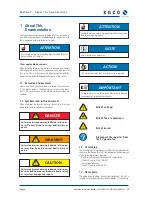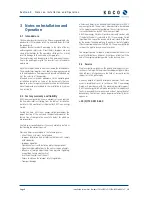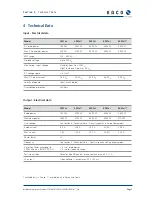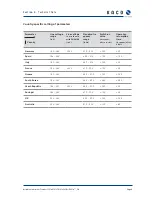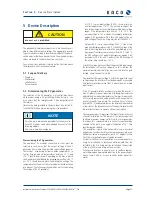
Installation Instructions Powador 1501xi/2501xi*/3501xi/4501xi/5001xi**_EN
Page 11
5 Device
Description
The galvanically isolated Powador xi units are currently avail-
able in three different power ratings. The appropriate inverter
type is selected according to the maximum output of the photo-
voltaic modules that have been installed. The maximum output
values are found in the data sheet (see section 4).
Your inverter’s designation is located on the front side above
the display as well as on the name plate.
5.1 Scope of delivery
Powador
–
Wall bracket
–
Installation kit
–
Documentation
–
5.2 Dimensioning the PV generator
The selection of the PV generator is of central importance
when dimensioning a PV installation. When doing so, you
must ensure that the solar generator is also compatible with
the inverter.
Observe the data provided in the data sheet (see section 4,
Technical Data) when dimensioning the solar generator.
Dimensioning the PV generator:
The number of PV modules connected in series must be
selected in such a way that the output voltage of the PV
generator stays within the permitted input voltage range of
the inverter - even during extreme outside temperatures. In
Central Europe, module temperatures between -10 °C and
+70 °C should be assumed. Depending on the way in which
the modules are installed and the geographic location, +60 °C
or +70 °C should be used when calculating the voltage. The
temperature coeffi cients of the solar modules should be taken
into account. The following criteria must be met for calculating
the voltage of the PV generator:
U
–
0
(-10 °C) < max. input voltage (500 V
DC
). Even at very low
outside temperatures (-10 °C), the no-load voltage of the
connected string must lie within the permitted input voltage
range. If the temperature falls from 25 °C to -10 °C, the
no-load voltage in 12 V modules, for example, increases by
approx. 2.8 V per module (5.6 V for a 24 V module). The no-
load voltage of the entire string must be less than 500 V.
UMpp (+60 °C) > min. input voltage (125 V
–
DC
). Even at very
high outside temperatures (+60 °C), the MPP voltage of the
connected string should lie within the permitted input volt-
age range. If the temperature increases from 25 °C to 60 °C,
the MPP voltage in 12 V modules decreases by approx. 3.6 V
per module (7.2 V for a 24 V module). The MPP voltage of
the entire string should be > 125 V.
If the MPP voltage moves outside of the permitted input range,
the installation still functions properly. In this situation, the
maximum possible amount of power is not fed into the grid;
instead, a small amount less is fed.
Provided that the input voltage is within the permitted input
voltage range, the inverter will not be damaged if a connected
PV generator provides current that is above the max. usable
input current.
If the PV generator briefl y provides more than the inverter’s
max. PV generator power, especially with changing cloud cover
and relatively low module temperatures, the inverter may switch
off for safety reasons and automatically switch on again after
a country-specifi c time period. The overload status is shown
by a red LED (3) and as plain text on the display. Under normal
circumstances, the dynamic control of the inverter ensures that
the inverter continues to operate without interruption.
The solar generator still represents the largest factor in the cost
of a solar installation. For this reason, it is extremely important
to obtain maximum energy yields from the solar generator.
To achieve this, solar generators in Central Europe should be
oriented to the south at an angle of inclination of 30°. They
should never be shaded.
This orientation is quite often not possible from a structural
perspective. In order to achieve the same energy yield as an
optimally oriented solar generator (south, 30° angle of inclina-
tion), the solar generator power can be increased.
For roofs with an east-west orientation, we recommend a two-
string PV installation. To achieve an optimum yield from the
installation, the fi rst string must be installed on the east side
of the roof; the second string on the west side.
For exposed locations in mountains or in southern regions,
we recommend an appropriate reduction in the power ranges.
Please consult with us or your specialty dealer about this
matter.
S e c t i o n 5 ·
D e v i c e D e s c r i p t i o n
CAUTION
Incorrect use is prohibited.
NOTE
KacoCalc pro, a dimensioning program for the easy selec-
tion of PV modules, can be downloaded at no cost at the
following address:
http://www.kaco-newenergy.de








